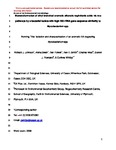Aerobic biotransformation of alkyl branched aromatic alkanoic naphthenic acids via two different pathways by a new isolate of Mycobacterium.
| dc.contributor.author | Johnson, RJ | en |
| dc.contributor.author | West, CE | en |
| dc.contributor.author | Swaih, AM | en |
| dc.contributor.author | Folwell, BD | en |
| dc.contributor.author | Smith, BE | en |
| dc.contributor.author | Rowland, SJ | en |
| dc.contributor.author | Whitby, C | en |
| dc.date.accessioned | 2016-01-26T15:26:36Z | |
| dc.date.available | 2016-01-26T15:26:36Z | |
| dc.date.issued | 2012-04-01 | en |
| dc.identifier.uri | http://hdl.handle.net/10026.1/4233 | |
| dc.description.abstract |
Naphthenic acids (NAs) are complex mixtures of carboxylic acids found in weathered crude oils and oil sands, and are toxic, corrosive and persistent. However, little is known about the microorganisms and mechanisms involved in NA degradation. We isolated a sediment bacterium (designated strain IS2.3), with 100% 16S rRNA gene sequence identity to Mycobacterium aurum, which degraded synthetic NAs (4'-n-butylphenyl)-4-butanoic acid (n-BPBA) and (4'-t-butylphenyl)-4-butanoic acid (t-BPBA). n-BPBA was readily oxidized with almost complete degradation (96.8% ± 0.3) compared with t-BPBA (77.8% ± 3.7 degraded) by day 49. Cell counts increased fourfold by day 14 but decreased after day 14 for both n- and t-BPBA. At day 14, (4'-butylphenyl)ethanoic acid (BPEA) metabolites were detected. Additional metabolites produced during t-BPBA degradation were identified by mass spectrometry of derivatives as (4'-carboxy-t-butylphenyl)-4-butanoic acid and (4'-carboxy-t-butylphenyl)ethanoic acid; suggesting that strain IS2.3 used omega oxidation of t-BPEA to oxidize the tert-butyl side-chain to produce (4'-carboxy-t-butylphenyl)ethanoic acid, as the primary route for biodegradation. However, strain IS2.3 also produced this metabolite through initial omega oxidation of the tert-butyl side-chain of t-BPBA, followed by beta-oxidation of the alkanoic acid side-chain. In conclusion, an isolate belonging to the genus Mycobacterium degraded highly branched aromatic NAs via two different pathways. | en |
| dc.language.iso | en | en |
| dc.title | Aerobic biotransformation of alkyl branched aromatic alkanoic naphthenic acids via two different pathways by a new isolate of Mycobacterium. | en |
| dc.type | Journal Article | |
| plymouth.publication-status | Accepted | en |
| plymouth.journal | Environmental Microbiology | en |
| dc.identifier.doi | 10.1111/j.1462-2920.2011.02649.x | en |
| plymouth.organisational-group | /Plymouth | |
| plymouth.organisational-group | /Plymouth/Faculty of Science and Engineering | |
| plymouth.organisational-group | /Plymouth/Research Groups | |
| plymouth.organisational-group | /Plymouth/Research Groups/Marine Institute | |
| plymouth.organisational-group | /Plymouth/Users by role | |
| dcterms.dateAccepted | 2012-03-31 | en |
| dc.rights.embargoperiod | Not known | en |
| rioxxterms.versionofrecord | 10.1111/j.1462-2920.2011.02649.x | en |
| rioxxterms.licenseref.uri | http://www.rioxx.net/licenses/all-rights-reserved | en |
| rioxxterms.licenseref.startdate | 2012-04-01 | en |
| rioxxterms.type | Journal Article/Review | en |


